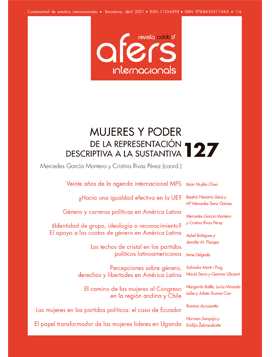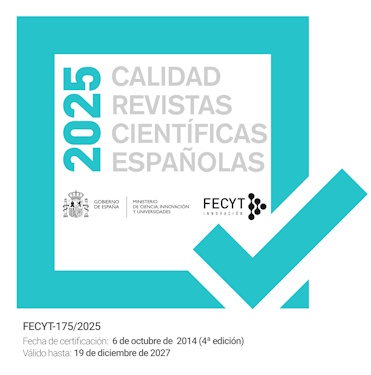Los techos de cristal en los partidos políticos latinoamericanos
Palabras clave:
partidos políticos, América Latina, élites politicas, brecha de género, techo de cristalResumen
Revista CIDOB d’Afers Internacionals, n.º 127
Cuatrimestral (enero-abril)
ISSN:1133-6595
E-ISSN:2013-035X
DOI: doi.org/10.24241/rcai.2021.127.1.121
Las cuotas de género han alterado sustancialmente la distribución de mujeres en los parlamentos de América Latina, así como las pautas de reclutamiento de los partidos. No obstante, aún existe un vacío en los análisis del impacto de este fenómeno en el interior de los partidos. La presente investigación analiza datos de la élite parlamentaria latinoamericana con el objetivo de prestar una especial atención a la valoración de las mujeres electas respecto de las dinámicas de equilibrio de género en el interior de sus partidos políticos. Se constata que existe un techo de cristal que impide que estas ocupen puestos de relevancia en la toma de decisiones dentro del partido, reduciéndose el marco de oportunidades para ascender dentro de la organización.
Este trabajo se enmarca en el proyecto de investigación RTI2018-094972-B-I00 «El rol representativo de mujeres y hombres en los parlamentos latinoamericanos», financiado por el Ministerio de Innovación, Ciencia y Universidades de España (investigadores principales: Dr. Manuel Alcántara y Dra. Mercedes García Montero).
Citas
Adams, Susan. «Influences upon parity: an analysis of factors affecting female representation in national legislatures». The International Journal of Diversity in Organisations, Communities and Nations, vol. 5, n.° 6 (2006), p. 75-86.
Alcántara, Manuel. «De políticos y política: profesionalización y calidad en el ejercicio público». Perfiles Latinaoamericanos, vol.21, n.° 41 (2013), p. 19-44.
Allés, Santiago. «¿Hacia la consolidación política? Cambios en la estructura de oportunidades electorales de las mujeres en Argentina». América Latina Hoy, n.° 47 (2007), p.123-154.
Alles, Santiago. «Ideología partidaria, competencia electoral y elección de legisladoras en cinco democracias latinoamericanas: Argentina, Brasil, Chile, Perú y Uruguay, 1980-2013». América Latina Hoy, n.° 66 (2014), p. 69-94.
Archenti, Nélida y Tula, María Inés (coords.). La representación imperfecta. Logros y desafíos de las mujeres políticas. Buenos Aires: Eudeba, 2014.
Barnes, Tiffany D. Gendering legislative behavior. Institutional constraints and collaboration. Cambridge: Cambridge University Press, 2016.
Barragán, Melany y Bohigues, Asbel. «New political parties in Latin America: a new way of selection and new elite profiles». En: Coller, Xavier; Cordero, Guillermo y Castillo, Antonio Jaime (eds.). The selection of politicians in time of crisis. Oxon: Routledge, 2018, p. 165-188.
Batlle, Margarita. «Partidos políticos y participación de las mujeres en Colombia: ¿hacia estructuras más inclusivas?». En: Freidenberg, Flavia y Muñoz-Pogossian, Betilde (eds.). Reformas a las organizaciones de partidos en América Latina (1978-2015). Lima: Pontificia Universidad Católica del Perú y OEA, 2016, p. 235-259.
Caminotti, Mariana y Piscopo, Jennifer M. «Neither penalised nor prized: feminist legislators, women’s representation and career paths in Argentina». Journal of Politics in Latin America, vol. 1, n.° 2 (2019), p. 181-203.
Childs, Sarah. «Women MPs in the House of Commons: a women’s style of politics?». Annual meeting of the American Political Science Association, San Francisco, (30 agosto-2 septiembre), 2001.
Childs, Sarah y Withey, Julie. «Women representatives acting for women: sex and the signing of early day motions in the 1997 British parliament». Political Studies, vol. 52, n.° 3 (2004), p. 552-564.
Coller, Xavier, Cordero, Guillermo y Jaime, Antonio M. (eds.). The Selection of Politicians in Times of Crisis. Londres: Routledge, 2020.
Cowley, Philip y Childs, Sarah. «Too spineless to rebel? New Labour’s women MPs». British Journal of Political Science, vol. 33, n.° 3 (2003), p. 345-365.
Dahlerup, Drude y Friedenvall, Lenita. «Quotas as a ‘fast track’ to equal representation for women». International Feminist Journal of Politics, vol. 7, n.° 1 (2005), p. 26-48.
Engström, Richard L. «District magnitude and the election of women to the Irish Dail». Electoral Studies, vol. 6, n.° 2 (1987), p. 123-132.
Franceschet, Susan. Women and politics in Chile. Boulder, CO.: Lynne Rienner Publishers, 2005.
Hinojosa, Magda y Vázquez, Lorena. «Selección de candidaturas, partidos y mujeres en América Latina». En: Freidenberg, Flavia; Caminotti, Mariana; Muñoz-Pogossian, Betilde y Došek, Tomáš (eds.). Mujeres en la política. Experiencias nacionales y subnacionales en América Latina. México: UAM, 2018, p. 35-68.
Inglehart, Ronald F. y Norris, Pippa. Rising tide: gender equality and cultural Change. Cambridge: Cambridge University Press, 2003.
IPU-Inter-Parlamentary Union / Unión Interparlamentaria. Women in National Parliaments. Database. IPU, (2019) (en línea) [Fecha de consulta: 18.03.2020] https://data.ipu.org/women-ranking?month=4&year=2020
Jones, Mark P. «Quota legislation and the election of women: learning from the Costa Rican experience». The Journal of Politics, vol. 66, (2004), p. 1.203-1.223.
Kenny, Meryl. «Gender, institutions and power: a critical review». Politics, vol. 27, n.° 2 (2007), p. 91-100.
Kenworthy, Lane y Malami, Melissa. «Gender inequality in political representation: a worldwide comparative analysis». Social Forces, vol. 78, (1999), p. 235-269.
Kittilson, Miki C. «Women’s representation in Parliament: the role of political parties». Party Politics, n.° 5 (1999), p. 79-98.
Kittilson, Miki C. Challenging parties, challenging parliaments: women and elected office in contemporary Western Europe. Columbia: The Ohio State University Press, 2006.
Kittilson, Miki C. «Party politics». En: Waylen, Georgina; Celis, Karen, Kantola, Johanna y Weldon, S. Laurel (eds.). The Oxford Handbook of Gender and Politics. Oxford: Oxford University Press, 2013, p. 536-553.
Krook, Mona L. «Gender quotas as a global phenomenon: actors and strategies in quota adoption». European Political Science, vol. 3, n.° 3 (2004), p. 59-65.
Krook, Mona L. «Reforming representation: the diffusion of candidate gender quotas worldwide». Politics and Gender, vol. 2, n.° 3 (2006), p. 303-327.
Krook, Mona L. Quotas for Women in Politics: Gender and Candidate Selection Reform Worldwide. Nueva York: Oxford University Press, 2009.
Lovenduski, Jon y Norris, Pippa (eds.). Gender and Party Politics. Londres: Sage, 1993.
Llanos, Beatriz y Roza, Vivian. Partidos políticos y paridad. Un desafío de la democracia en América Latina. Perú:BID e IDEA, 2015.
Llanos, Beatriz y Roza, Vivian. «Más poder, menos mujeres: desigualdades de género en los partidos políticos latinoamericanos». En: Freidenberg, Flavia; Caminotti, Mariana; Muñoz-Pogossian, Betilde y Došek, Tomáš (eds.). Mujeres en la política. Experiencias nacionales y subnacionales en América Latina. México: UAM, 2018, p. 69-98.
Matland, Richard E. y Brown, Deborah. «District magnitude’s effect on female representation in State legislatures». Legislative Studies Quarterly, vol. 17, n.° 4 (1992), p. 469-492.
Matland, Richard E. y Studlar, Donley T. «The contagion of women candidates in single-member district and proportional representation electoral systems: Canada and Norway». Journal of Politics, vol. 58, n.° 3 (1996), p. 707-733.
McAllister, Ian y Studlar, Donley T. «Electoral systems and women’s representation: a long-term perspective». Representation, vol. 39, n.° 1 (2002), p. 3-14.
Murray, Ralph. «Second among equals? A study of whether France’s quota women are up to the job». Politics and Gender, vol. 6, n.° 1 (2010), p. 93.118.
Nanivadekar, Medha. «Are quotas a good idea? The Indian experience with reserved seats for women». Politics and Gender, vol.2, n.° 1 (2006), p. 119-128.
Norris, Pippa. «Women’s legislative participation in Western Europe». West European Politics, vol. 8, n.° 4 (1985), p. 90-101.
Norris, Pippa. «Conclusions: Comparing Legislative Recruitment». En: Lovenduski, Jon y Norris, Pippa (eds.). Gender and Party Politics. Londres: Sage, 1993.
Norris, Pippa. «Legislative Recruitment». En: LeDuc, Laurence; Niemi, Richard G. y Norris, Pippa (eds.). Comparing Democracies: Elections and Voting in Global Perspective. Londres: Sage, 1996, p. 184-215.
Norris, Pippa. Passages to Power. Legislative recruitment in advanced democracies. Cambridge: Cambridge University Press, 1997.
O’Brien, Diana Z. y Piscopo, Jennifer M. «Electing Women to National Legislatures», en: Alexander, Amy C.; Bolzendahl, Catherine y Jalalzai, Farida (eds.). Measuring Women’s Political Empowerment across the Globe: Strategies, Challenges, and Future Research, Nueva. York: Palgrave Macmillan, 2017, p. 139-163.
O’Neill, Brenda y Stewart, David K. «Gender and political party leadership in Canada». Party Politics, vol. 15, n.° 6 (2009), p. 737-757.
Oakes, Ann y Almquist, Elizabeth. «Women in national legislatures: a cross-national test of macrostructural gender Theories». Population Research Policy and Review, vol. 12, n.° 1 (1993), p. 71-81.
PNUD-Programa de las Naciones Unidas para el Desarrollo. Mujeres y política. Un panorama sobre la adopción de las cuotas de género y sus efectos en América Latina y Colombia. Bogotá: Colombia, 2015.
Ríos, Marcela y Villar, Andrés. Cuotas de género. Democracia y representación. Santiago de Chile: Flacso-Chile e IDEA, 2006.
Roza, Vivien. Gatekeepers to power: party-level influences on women‟s political participation in Latin America. Tesis doctoral, Universidad de Georgetown, 2010 (en línea) https://repository.library.georgetown.edu/bitstream/handle/10822/553105/rozaVivian.pdf%3Bjsessionid%3DDC22C396D5AE0B34960A670387D269A4?sequence%3D1
Rule, Wilma. «Why women don’t run: the critical contextual factors in women’s legislative recruitment». Western Political Quarterly, vol.34, n.° 2 (1981), p. 60-77.
Rule, Wilma. «Electoral systems, contextual factors and women’s opportunity for election to Parliament in twenty-three democracies». Western Political Quarterly, vol. 40, n.° 3 (1987), p. 477-498.
Saint-Germain, Michelle A. «Paths to power of women legislators in Costa Rica and Nicaragua». Women’s Studies International Forum, vol. 16, n.° 2 (1993), p. 119-138.
Schmidt, Gregory D. «The election of women in list PR systems: testing the conventional wisdom». Electoral Studies, vol. 28, n.° 2 (2008), p. 190-203.
Schwindt-Bayer, Leslie A. Political Power and Women’s Representation in Latin America. Nueva York: Oxford University Press, 2010.
Tameruis, Karin L. «Sex, gender and leadership in the representation of women». En: Duerst-Lahti, Georgia y Kelly, Rita M. (eds.). Gender power, leadership and governance. Ann Arbor: The University of Michigan Press, 1995, p. 93-112.
Trimble, Linda y Arscott, Jane. Still counting: Women in politics across Canada. Peterborough: Broadview, 2003.
Verge, Tania. «Cuotas de género y reclutamiento político. Análisis del Parlament de Catalunya, 1980-2010». Revista Española de Ciencia Política, n.° 26 (2011), p. 87-104.
Welch, Susan y Studlar, Donley T. «Multi-member districts and the representation of women: evidence from Britain and the Unites States». The Journal of Politics, vol. 52, n.° 2 (1990), p. 391-412.
Wolinetz, Steven B. «Más allá del partido catch-all». En: Montero, José Ramón, Gunther, Richard y Linz, Juan José (eds.). Partidos políticos. Viejos conceptos y nuevos retos. Madrid: Trotta, 2007, p. 127-164.













